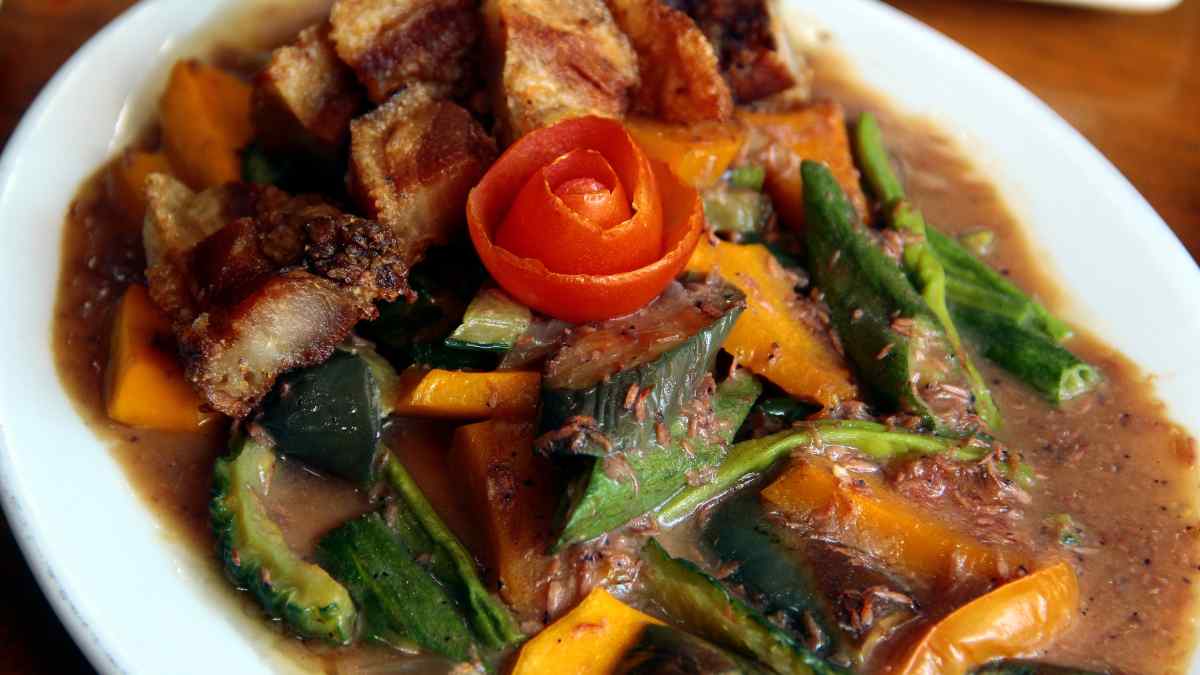Dear parents and caregivers! April here helping you relax into motherhood from my tropical island home.
You know the way a certain smell can instantly transport you to a long-forgotten moment in time? The smell of Pinakbet Ilocano simmering on the stove can work that same kind of magic.
As children, my siblings and I would come home from school to the familiar aroma of my father’s Pinakbet cooking – who, as some of you might know is a true blue Ilocano (including his politics, lol). But anyway, Pinakbet is a beloved Filipino dish of boiled (or stewed?!) vegetables in alamang (shrimp paste). The mélange of scents – garlicky shrimp paste and sweet vegetables- would effortlessly conjure memories of home and family dinners.
What is Pinakbet
Pinakbet hails from the Ilocos region in Central Philippines. The dish is simple in premise yet profoundly complex, and I like the mix of bitter from ampalaya, and sweet from kalabasa (squash) as well as the native eggplant. A true blue Pinakbet Ilocano recipe reliably contains native eggplant (those green fat eggplants not the long violet ones) and okra, the twin towers of any pinakbet. But recipes vary wildly, with people vigorously advocating for their favored additions – beans, ampalaya (bitter melon), sitaw (string beans), bunga ng Malunggay, sigarilyas (winged beans), and more.
Unlike many traditional dishes which have a reputation for being laborious and time-consuming, Pinakbet Ilocano is a throw-it-together and it gets cooked dish. The basic recipe can be prepared in less time than a Kdrama episode. This is actually the difference with Tagalog Pinakbet where the vegetables are stir-fried. Pinakbet is more like stew or vegetable soup. The preparation involves no complicated skills. There are no strict recipes to decode, no special tools are needed. Just stirring the pot as the flavors slowly mingle and fill your kitchen with aromas transporting you across space and time.
Pinakbet Ingredients
You just need three things: aromatics, ‘mats and ‘tudes. I know, I know, that’s a bit forced, lol.
By aromatics, I mean the salty essence that brings pinakbet to life – ginger and shrimp paste. Simmer it in water to create the fragrant ‘mat, or foundation, that infuses the other ingredients. This step is so critical, it will make or break your entire operation, like Denzel in “Man on Fire.” I often wondered what it is Im doing wrong that my Pinakbet doesn’t taste like mu father’s Pinakbet and turns out, I’m missing the first step and because I’m a Tagalog that defaults to stir frying the Pinakbet first.
Next are the ‘mats – the array of fresh vegetables you drop on the boiling soup. Focus on fewer rather than more types for your first pinakbet. Eggplant, okra, kalabasa, are the holy trinity that form a solid base to build upon in future experiments. I like my kalabasa almost squashed as it gives a creamier texture. My father actually uses camote (sweet potatoes) and I think this is the more traditional ingredient than kalabasa.
Finally, adopt the right ‘tude. Pinakbet uses an easygoing, unfussy cooking style – chopping ingredients into roughly equal sizes and stir-frying until just tender – will serve you well here. In fact, I’m usually buying the pre-chopped vegetables in the market. Opps! The beauty of pinakbet lies in its rustic, homey simplicity – not gourmet perfection.
So go ahead, gather your aromatics and ‘mats. Adopt an uncomplicated ‘tude. With just 30 minutes and a handful of basic ingredients, you too can cook your Pinakbet – a dish that stirs something deep within – transporting you momentarily to that place where food, family, and memories meet.
Here’s the Pinakbet recipe!
Ingredients
Shopping list:
- 1/2 kilo pork belly
- 2 medium tomatoes
- 2 tablespoons alamang (shrimp paste)
- 1/2 squash
- 4 okra
- 2 eggplants
- 1 bitter gourd
- 1 bundle green beans
- 1 bundle sigarilyas
Pantry:
- Water
- 2 onions
- 1 inch ginger
Tools:
- Knives
- Cutting board
- Large saucepan or pot
- Frying pan
- Tongs
Instructions
- Fry the pork belly in oil until browned and crispy. Set aside.
- Cut vegetables into bite-sized pieces. Soak bitter gourd in water with salt to remove bitterness.
- Put together 2-3 cups water. alamang (shrimp paste) , onions, and ginger in a pot and bring to a boil,.
- Add vegetables, starting with squash then okra. When squash is soft, add the rest of the vegetables.
- Simmer until tender, about 15 minutes.
- Add the fried pork belly and mix well.
- Transfer to a bowl and serve with rice.
Notes
Deep frying the pork belly at a moderate temperature helps render the fat and ensures crispy skin.
Add vegetables in order of longest to shortest cooking time.
You can substitute chicken thighs for the pork belly.
For vegetarians, omit the pork belly and use extra oils, nuts, or seeds to add richness.
For tired parents, pinakbet offers a kind of small awakening from our routines. An invitation into the kitchen where simplicity still holds the power to bring that carousel of tastes to our weary tables. Let me know if this inspires you to make pinakbet for your loved ones! You can hit me up at relaxlangmom.com for recipe hacks and ingredient substitutions to make this beloved Filipino vegetable stir fry your own.
Relish the simple,
April
relaxlangmom.com
@filipinorecipe #pinakbet #vegetables #makulayangbuhaysasinabawanggulay


